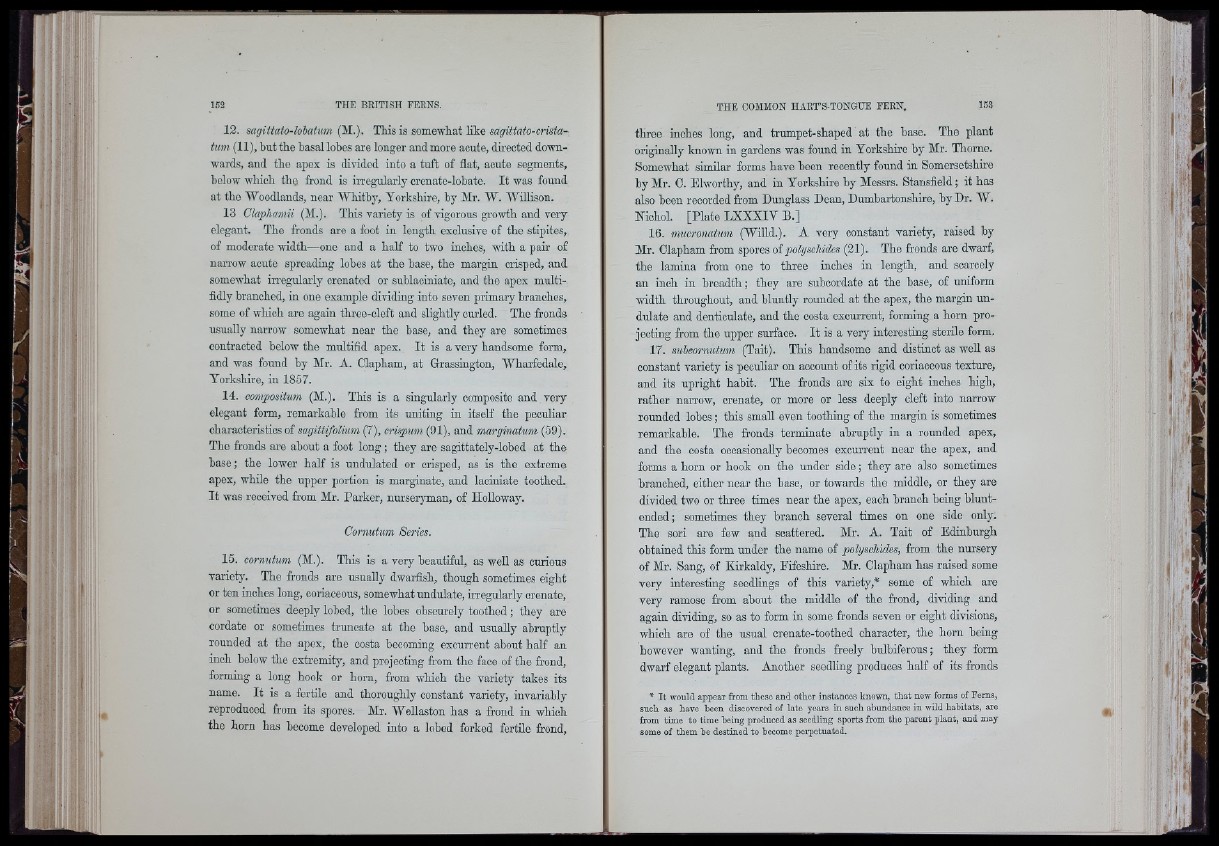
’ii
r i
ri i
'!r:
4
i:r
I■■' r i i ‘7I :■;i-
■■' ii!
12. sagittato-lohatum (M.). This is somewhat like sagittaio-erista-
tum (11) , but tbe basal lobes are longer and more acute, directed downwards,
and tbe apex is divided into a tuft of flat, acute segments,
below which the frond is irregularly crenatc-lobate. It was found
at tho Woodlands, near Whitby, Yorkshire, by Mr. W. Willison.
13 Claphamii (M.). This variety is of vigorous growth and very
elegant. The fronds are a foot in length exclusive of the stipites,
of moderate width—one and a half to two inches, with a pair of
narrow acute spreading lobes at the base, tho margin crisped, and
somewhat irregularly crenated or suhlaciniato, and the apex multifidly
branched, in one example dividing into seven primary branches,
some of which are again three-oleft and slightly curled. The fronds
usually narrow somewhat near tho base, and they are sometimes
contracted below tho multifid apex. It is a very handsome form,
and was found by Mr. A. Clapham, at Grassington, Wharfedale,
AYrkshire, in 1867.
14. compositum (M.). This is a singularly composite and very
elegant form, remarkable from its uniting in itself the peculiar
characteiistlcs of sagittifoUum (7), crispum (91), and marginatum (69).
The fronds are about a foot long ; they are sagittately-lohed at the
base; the lower half is undulated or crisped, as is the extreme
apex, while the upper portion is marginate, and laoiniate toothed.
It was received from Mr. Parker, nurseryman, of Holloway.
Cornutum Series.
15. conmtum (M.). This is a very beautiful, as well as curious
variety. The fronds are usually dwarfish, though sometimes eight
or ten inches long, coriaceous, somewhat undulate, irregularly crenate,
or sometimes deeply lobod, the lobes obscurely toothed ; they are
cordate or sometimes truncate at the base, and usually abruptly
rounded at the apex, the costa becoming exourrent about half an
inch below the extremity, and projecting from the face of the frond,
forming a long hook or horn, from which the variety takes its
name. It is a fertile and thoroughly constant variety, invariably
reproduced from its spores. Mr. AYellaston has a frond in which
the horn has become developed into a lobed forked fertile frond.
throe inches long, and trumpet-shaped at the base. The plant
originally known in gardens was found in Yorkshire by Mr. Thorne.
Somewhat similar forms have been recently found in Somersetshire
by Mr. 0. Elworthy, and in Yorkshire by Messrs. Stansfleld; it has
also been recorded from Dunglass Dean, Dumbartonshire, by Dr. W .
Nichol. [Plate LXXXIV B.]
16. mucronatum (Willd.). A very constant variety, raised by
Mr. Clapham from spores oi polyschides (21). The fronds are dwarf,
the lamina from one to throe inches in length, and scarcoly
an inch in breadth; they are suboordate at the base, of uniform
width throughout, and bluntly rounded at tho apex, the margin undulate
and denticulate, and the costa exourrent, forming a horn projecting
from the upper surface. It is a very interesting sterile form.
17. subeormdum (Tait). This handsome and distmot as well as
constant variety is peculiar on account of its rigid coriaceous texture,
and its upright habit. The fronds are six to eight inches high,
rather narrow, crenate, or more or less deeply cleft into narrow
rounded lobes; this smaU even toothing of the margin is sometimes
remarkable. The fronds terminate abruptly in a rounded apex,
and the costa occasionally becomes exourrent near the apex, and
forms a horn or hook on the under side; they are also sometimes
branched, either near the base, or towards the middle, or they are
divided two or three times near the apex, each branch being hlunt-
ended; sometimes they branch several times on one side only.
The sori are few and scattered. Mr. A. Tait of Edinburgh
obtained this form under the name of polyschides, from the nursery
of Mr. Sang, of Kirkaldy, Fifeshire. Mr. Clapham has raised some
very interesting seedlings of this variety,* some of which are
very ramose from about the middle of the frond, dividing and
again dividing, so as to form in some fronds seven or eight divisions,
which are of the usual crenate-toothed character, the horn being
however wanting, and the fronds freely hulbiferous; they form
dwarf elegant plants. Another seedling produces half of its fronds
* I t would appear from these and other instances known, th a t new forms of Ferns,
such as have been discovered of la te years in such abundance in wild habitats, are
from time to time being produced as seedling sports from th e p a ren t plant, and may
some of them be destined to become pei-petuatcd.
'kJ
i ■-1
■■■=' 'Rl
'ii ' \
■v|'i
y '-A
' i ' !
'(friS
■ri!,
r i
it